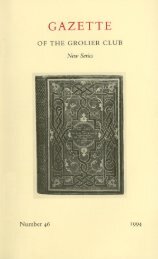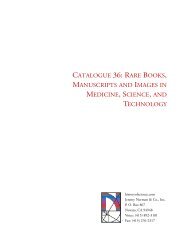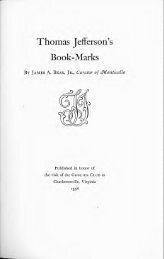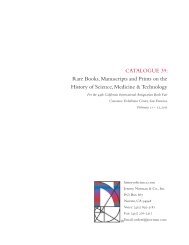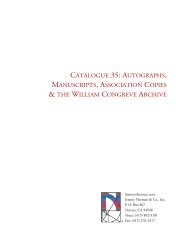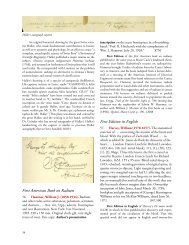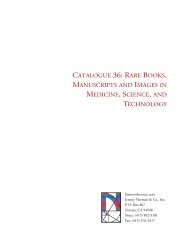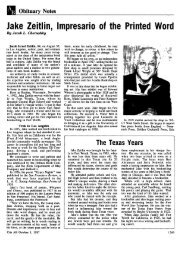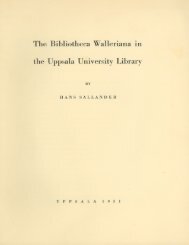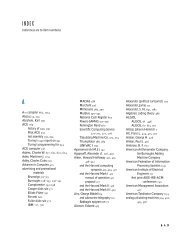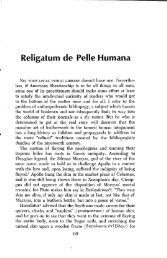Catalogue 38, Part 3 - Jeremy Norman's HistoryofScience.com
Catalogue 38, Part 3 - Jeremy Norman's HistoryofScience.com
Catalogue 38, Part 3 - Jeremy Norman's HistoryofScience.com
Create successful ePaper yourself
Turn your PDF publications into a flip-book with our unique Google optimized e-Paper software.
mechanics to visible and tangible objects. In the fifth<br />
section of his paper (p. 812), he set forth the “quite<br />
burlesque” case of a cat<br />
penned up in a steel chamber, along with the following<br />
diabolical apparatus (which must be<br />
secured against direct interference by the cat): in a<br />
Geiger counter there is a tiny bit of radioactive<br />
substance, so small, that perhaps in the course of<br />
the hour one of the atoms decays, but also, with<br />
equal probability, perhaps none; if it happens, the<br />
counter tube discharges and through a relay<br />
releases a hammer which shatters a small flask of<br />
hydrocyanic acid. If one has left this entire system<br />
to itself for an hour, one would say that the cat<br />
still lives if meanwhile no atom has decayed. The<br />
psi-function of the entire system would express<br />
this by having in it the living and dead cat (pardon<br />
the expression) mixed or smeared out in equal<br />
parts.<br />
It is typical of these cases that an indeterminacy<br />
originally restricted to the atomic domain<br />
be<strong>com</strong>es transformed into macroscopic indeterminacy,<br />
which can then be resolved by direct observation.<br />
That prevents us from so naively accepting<br />
as valid a “blurred model” for representing reality.<br />
In itself it would not embody anything unclear or<br />
contradictory. There is a difference between a<br />
shaky or out-of-focus photograph and a snapshot<br />
of clouds and fog banks (Schrödinger, “The present<br />
situation in quantum mechanics,” translated<br />
by John D. Trimmer [Proceedings of the American<br />
Philosophical Society 124 (1980): 323-<strong>38</strong>]).<br />
This conclusion sets forth what has been called the<br />
principle of state distinction: “states of a macroscopic<br />
system which could be told apart by a macroscopic<br />
observation are distinct from each other whether<br />
observed or not” (Moore, p. 308). Schrödinger’s paper<br />
represents “his definitive statement about the theory<br />
that he and Heisenberg had discovered” (Moore, p.<br />
307). Moore, Schrödinger: Life and Thought, pp. 306-9.<br />
40521<br />
From One of the Founders of<br />
Modern Geology<br />
95. Sedgwick, Adam (1785-1873). Two autograph<br />
letters signed to [James] Marshall. Dent<br />
[Yorkshire], Oct. 7, 1857; Trinity College [Cambridge],<br />
Oct. 31, 1857. 8pp. total. 186 x 113 mm.<br />
Light soiling along folds, but very good. $950<br />
Letters with excellent scientific content from one<br />
of the founders of modern geology. Sedgwick was<br />
responsible for defining the Devonian and Cambrian<br />
ages in the geological time scale, and his immensely<br />
popular lecture courses on geology, delivered annually<br />
at Cambridge between 1819 and 1870, had an enormous<br />
influence on succeeding generations of English<br />
geologists. One of his students was Charles Darwin,<br />
who began attending Sedgwick’s lectures in January<br />
1831 and ac<strong>com</strong>panied Sedgwick on a geological field<br />
tour of Wales the following summer. The two men<br />
remained friends until Sedgwick’s death, even though<br />
Sedgwick was never able to accept Darwin’s theory of<br />
evolution by natural selection.<br />
84



